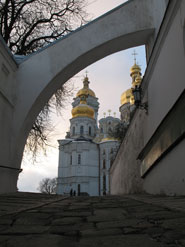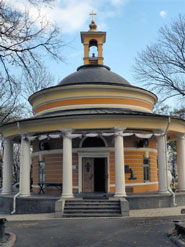Pechersk
|
One of the oldest historical parts of Kiev is Pechersk (Kiev Pechersk, Pechersk hill, Pechersk plateau). The most popular version about the origin of the name “Pechersk” is connected with word “cave” – “pechera” on ancient Rus language – and, obviously, with caves of the Kiev Pechersk monastery, where first monks settled. Though, there is an opinion that caves could already exist on this place and around even before the foundation of monastery. Another version explains the name of the quarter according to specialty of local relief, because in ancient times word “Pechera” was also used to signify steep hills near the river.
From 12th century, Pechersk enlarges and becomes settled. In 18 century, territory of Lavra grows and turns to a fortress. 100 years later Pechersk becomes an aristocratic quarter, and in 20th – administrative center of Kiev with all government edifices.
|
 |
In ancient times, Pechersk was divided into smaller localities, which names still exist.
Berestovo – estate of old Kiev princes, situated next to the upper part of Kiev Pechersk monastery. Vladimir the great was the first among princes who choose this place for country seat. Later other princes lived there. The church of Savior on Berestovo was erected in this locality, and it stays till nowadays.
|
Askold's Grave, or Hungarian ravine – a deep coomb between Pechersk hills. First version of name is explained as a place of prince Askold burial mound. Saint Nicolas church dedicated to prince Askold was build there and stays now in Askold Grave Park. Hungarian ravine’s name originates from ancient Hungarian tribe that stayed there even before the foundation of Kiev.
Lipki (quarter of lindens) is a locality of noblesse. Once there were many linden trees, but now they are mostly chopped down and replaced with elite houses and other edifices.
Zverinets, Vydubichi – monastery localities, known from époque of princes. In different times there were country sides of rulers, fortifications, private houses and so on. Now here are Zverinets caves (not so widely known as Lavra caves), and Vydubitsky monastery.
|
 |


